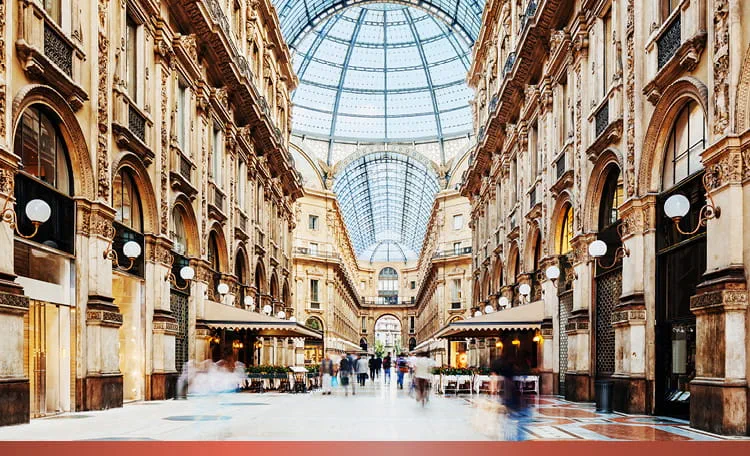• Via Montenapoleone in Milan has become the first European street in history to be ranked as the world's most expensive shopping avenue, surpassing Upper 5th Avenue in New York.
• Rent growth was recorded in 79 out of 138 monitored locations, with the global average increase standing at 4.4%.
In this year’s 34th edition of the Cushman & Wakefield Main Streets Across the World ranking, the Czech Republic, represented by Pařížská Street, secured 20th place. For the first time, a European street, Via Montenapoleone in Milan, claimed the title of the world’s most expensive shopping street, surpassing the American Upper 5th Avenue in New York. The most expensive street in Asia is Tsim Sha Tsui in Hong Kong.
The Main Streets Across the World survey compares nearly 50 countries, analyzing the most expensive shopping streets based on rental prices1 in 138 prime urban retail locations globally, many of which are associated with the luxury sector. For the third consecutive year, the Czech Republic is represented in this ranking by Pařížská Street. As of Q3 this year, the top achievable rent in Pařížská Street stands at €2,700 per square meter annually, or approximately €225 per square meter monthly. Although rents have remained unchanged compared to last year, Pařížská Street has moved down one spot in the country ranking.
Pařížská Street continues to hold growth potential, supported by ongoing projects along the street. Next year, the Fairmont Golden Prague, a five-star hotel, will open alongside a development at Pařížská 25. These projects will introduce a variety of new shops, including brands entering the market for the first time, as well as restaurants, bars, wellness centers, and other attractive concepts. Overall, the retail and leisure space on Pařížská Street will expand by approximately 15%, alongside the creation of a high-quality public space. The recent sale of the building at Pařížská 3, home to Louis Vuitton, handled by Cushman & Wakefield, further underscores the street's appeal to investors.
Other major shopping streets in Prague are also performing exceptionally well. Rents on Na Příkopě and the lower part of Wenceslas Square are around €220 per square meter monthly, ranking among the highest in the Czech Republic, second only to Pařížská Street.
Outside Prague, the second most expensive shopping destination in the Czech Republic is the city center of Brno, where rents on Česká Street, Masarykova Street, and Náměstí Svobody range between €65–70 per square meter monthly.
Jan Kotrbáček, Partner and Head of Retail Agency, Central & Eastern Europe, Cushman & Wakefield: “Pařížská Street in Prague has long been the primary destination for luxury brands entering Central and Eastern Europe. Each year, we see new stores from global luxury brands opening in the area—last year, for example, Polo Ralph Lauren and Jimmy Choo opened on Paris Street, while MooRER and Zadig & Voltaire established themselves in adjacent streets. This year, brands like Balmain Hair Couture and Le Labo have entered the market here. The Czech Republic and its capital are undoubtedly highly sought-after European destinations for luxury brands, and Pařížská Street offers a unique setting for showcasing luxury goods. This avenue and its surroundings remain unmatched as the most compact and visually stunning luxury destination in Central Europe, with the widest selection of represented brands set against the backdrop of the city’s historic center.”
Globally, Europe Takes the Lead, Followed by the USA
This year’s ranking of the world’s most expensive streets is unique: for the first time, a European shopping street has claimed the top spot. Via Montenapoleone in Milan surpassed Upper 5th Avenue in New York. Rents on this Italian street have risen by nearly a third over the past two years, while rents on Upper 5th Avenue remained unchanged for the second consecutive year. In addition to sustained strong demand from retailers and limited supply, the Milan Street also benefited from the strengthening of the euro against the US dollar.
New Bond Street in London took third place, surpassing Tsim Sha Tsui in Hong Kong. With a 10% year-on-year increase in rents, Paris’s Avenue des Champs-Élysées retained its fifth position, although Tokyo’s Ginza district narrowed the gap with a 25% year-on-year rent increase.
Rents and Ranking Changes
The positive rent growth across Western and Southern Europe reflected a strong influx of tourists during the Olympic year, bolstered by an increased number of visitors, particularly from the USA.
In Europe, Hungary recorded the highest rent growth. Váci utca in Budapest took the lead with a 27% increase. In absolute terms, New Bond Street in London topped the charts, with rents rising by $300, marking a 13% year-on-year increase.
At the other end of the spectrum, only two European locations saw a year-on-year decline in rents: Kalku Street in Riga and Ilica Street in Zagreb.
In the Americas, Miami's Design District led with a 66% year-on-year rent increase, the highest growth globally.
Overall, rent growth was observed in 79 of the 138 monitored locations, with the global average increase standing at 4.4%. The Americas emerged as the best-performing region with 11% year-on-year growth, while Europe and Asia experienced slower growth rates of 3.5% and 3.1%, respectively.
Table 1: Country Rankings by Most Expensive Shopping Streets

Source: Cushman & Wakefield
Outlook for the Luxury Sector
The ranking results indicate that major retail destinations have successfully overcome challenges posed by rising interest rates and weak economic growth. The retail sector is now benefiting from economic recovery and increasing consumer purchasing power.
Jan Kotrbáček, Partner and Head of Retail Agency, Central & Eastern Europe, Cushman & Wakefield: “The world’s most expensive shopping streets are defined by limited space availability, often unique architecture, intense competition, and their appeal primarily to the premium and luxury segments. Leading brands need to provide their customers with exceptional product presentation and shopping experiences, which is why they focus on physical stores in the best locations. As shown by this year’s ranking results, the premium and luxury market segments continue to grow, and we expect this trend to persist as conditions improve and tourists return to all major cities.”
Notes on the Main Streets Across the World methodology:
Selection of the streets to be benchmarked: The survey compared 138 premium retail streets; in the ranking of 49 countries, each country is represented by its most expensive street, i.e. the one with the highest achieved rent. Only one – the most expensive – street is included for each country: it is not a ranking of all the top expensive retail streets in the world (if it were, the results would differ and, for example, the Czech Republic would not rank so high because certain countries ranking higher than it have multiple streets that are more expensive than Pařížská).
The ‘most expensive street’ concept: This means the most expensive/attractive retail streets based on the amount of the rent – this is what reflects and determines the attractiveness of a street. The ranking does not work with the prices of goods – the streets are not the most expensive from the viewpoint of customer prices.
The rent amount parameter: The ranking works with the highest achieved amount of rent per sq m for an ideal 100 sq m of space (i.e., if the area is a multiple of that, the price is not simply multiplied) with the ideal conditions (e.g. the perfect shop windows) based on the ‘Zone A method’ used in Western Europe (rental value at a distance of 10 m from the shop window).
1 Premium shopping streets worldwide were compared, with each of the 49 countries in the ranking represented by one street featuring the highest achievable rent. More details about the ranking methodology can be found at the end of the report.
2 For the purpose of this ranking, Hong Kong is listed separately.














